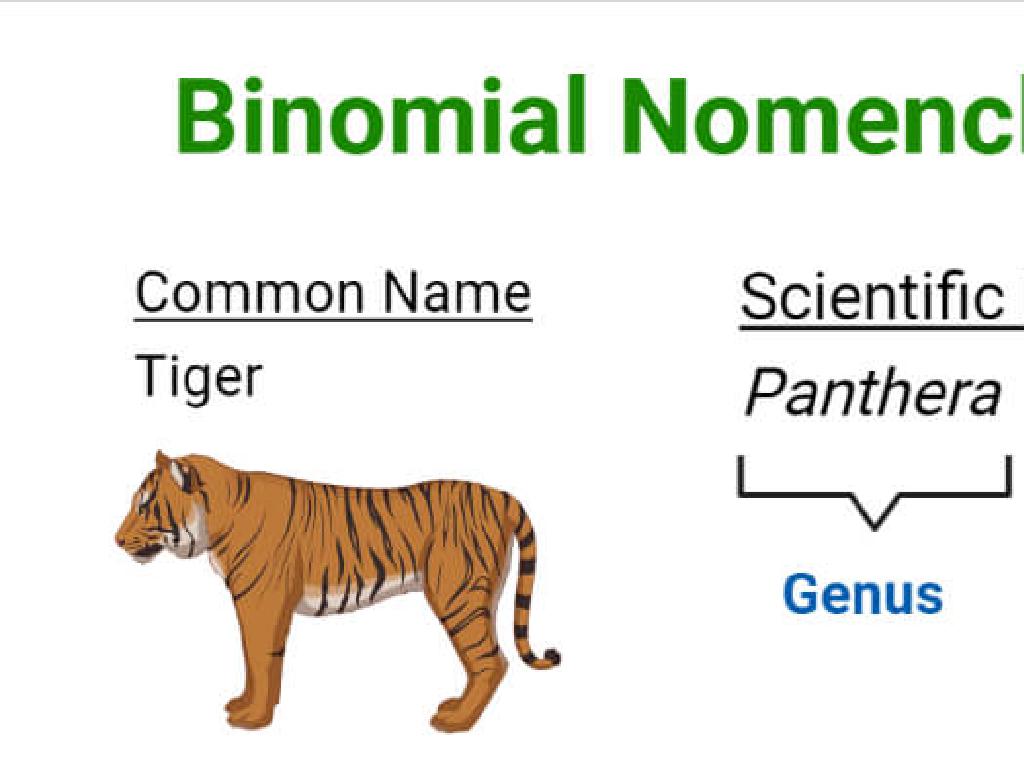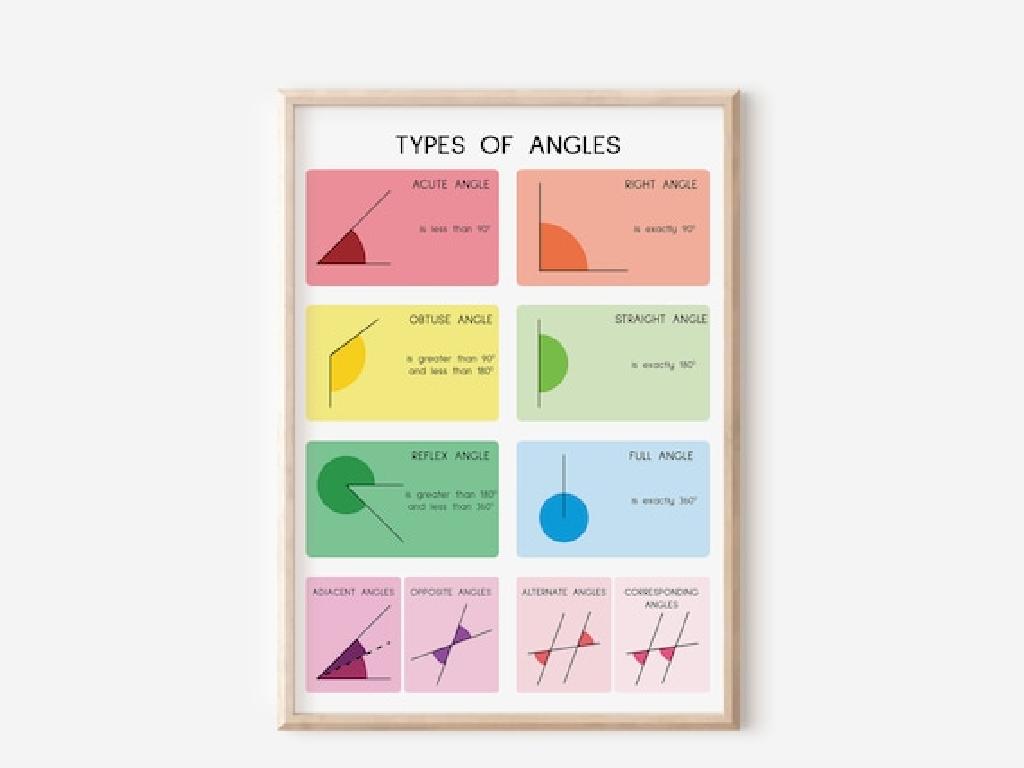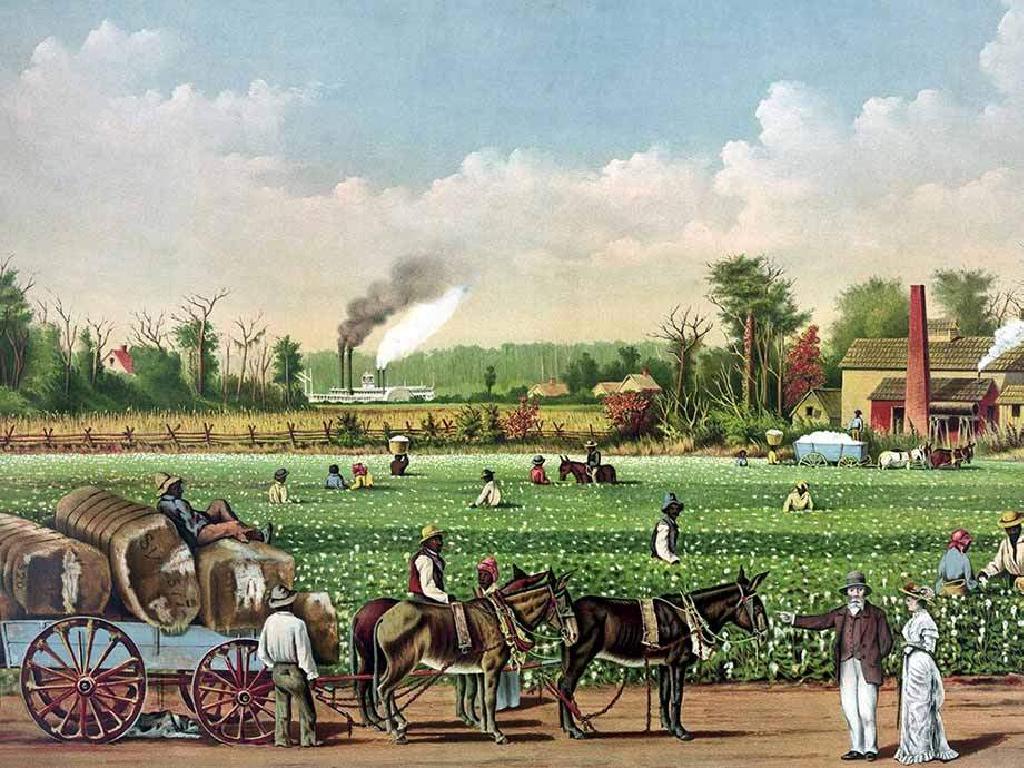Diffusion Across Membranes
Subject: Science
Grade: Sixth grade
Topic: Solutions
Please LOG IN to download the presentation. Access is available to registered users only.
View More Content
Introduction to Diffusion
– What is Diffusion?
– Movement of particles from high to low concentration
– Diffusion’s role in our bodies
– Essential for nutrient and oxygen distribution
– Diffusion’s impact on the environment
– Helps in the dispersal of pollutants and seeds
– Today’s focus: Diffusion across membranes
|
Begin the lesson by explaining diffusion as the process where particles move from an area of higher concentration to an area of lower concentration. Emphasize its importance in biological systems, such as the distribution of nutrients and oxygen in the body, and in ecological systems, such as the dispersal of pollutants in water or air and the spread of plant seeds. Conclude the introduction by stating that today’s lesson will focus specifically on how diffusion occurs across cell membranes, which is crucial for cellular function and homeostasis.
Understanding Diffusion
– Define Diffusion
– Movement of particles from high to low concentration
– Everyday examples of Diffusion
– Perfume aroma spreading, sugar dissolving in tea
– Diffusion in gases and liquids
– Gas molecules mix quickly without stirring
– Diffusion in solids
– Solids diffuse slower, like a copper patina forming over time
|
This slide introduces the concept of diffusion, a fundamental process in science. Begin with the definition, explaining that diffusion is the movement of particles from an area of higher concentration to an area of lower concentration. Provide relatable examples such as the smell of perfume dispersing in a room or sugar dissolving in tea to illustrate diffusion in everyday life. Discuss how diffusion occurs more rapidly in gases and liquids compared to solids, due to the difference in particle movement and spacing. Emphasize that diffusion is a natural, passive process that does not require energy. Use diagrams if possible to visually represent the process in each state of matter.
Membranes and Their Role in Cells
– Define a biological membrane
– A thin barrier that controls what enters and leaves a cell
– Explore types of membranes
– Cell membranes, nuclear membranes, and more
– Understand membranes in cells
– They protect the cell and manage the transport of substances
– Discuss membrane’s importance
|
This slide introduces students to the concept of biological membranes, which are crucial components of all cells. Start by defining a membrane as a selective barrier that regulates the movement of substances in and out of cells. Highlight the different types of membranes, such as the cell membrane, nuclear membrane, and others, emphasizing their diverse roles. Explain that membranes are responsible for protecting the cell and maintaining homeostasis by controlling the flow of ions and molecules. This understanding is foundational for later discussions on how substances like water and nutrients move across these membranes through processes such as diffusion.
Diffusion Across Membranes
– Substances crossing cell membranes
– Semi-permeable membranes explained
– Allows certain molecules to pass, not others
– Passive vs. Active transport
– Passive: no energy used, Active: energy required
– Examples of each transport type
– Osmosis (passive), Sodium-potassium pump (active)
|
This slide introduces the concept of how substances move across cell membranes, a key topic in understanding cellular functions. Emphasize the role of semi-permeable membranes, which act as selective barriers allowing only certain molecules to pass through. Contrast passive transport, where substances move without the use of cellular energy, with active transport, which requires energy to move substances against a concentration gradient. Use osmosis, the diffusion of water, as an example of passive transport, and the sodium-potassium pump as an example of active transport. Encourage students to think of other examples and to consider why a cell might need to use energy to move certain substances.
Factors Affecting Diffusion
– Temperature’s role in diffusion
– Higher temperatures increase the energy and movement of molecules, speeding up diffusion.
– Concentration gradient impact
– A difference in concentration between two areas can drive molecules to move from high to low concentration.
– Molecule size and membrane
– Larger molecules may diffuse more slowly and may require assistance to pass through membranes.
– Membrane permeability
– Permeability refers to how easily molecules can cross the membrane, affecting the rate of diffusion.
|
This slide aims to explain the various factors that can influence the rate and efficiency of diffusion across cell membranes. Temperature can affect the kinetic energy of molecules, thereby impacting how quickly they spread out. The concentration gradient is a primary driving force for diffusion, with molecules naturally moving from an area of higher concentration to one of lower concentration to reach equilibrium. The size of the molecules can also play a role; larger molecules may require transport proteins to help them cross the membrane. Lastly, membrane permeability is crucial as it determines how easily different substances can pass through the membrane. During the class, provide examples and possibly conduct experiments to demonstrate these concepts in a tangible way for the students.
Osmosis: A Special Type of Diffusion
– Understanding osmosis
– Osmosis is the movement of water through a membrane.
– Osmosis vs. diffusion
– Unlike diffusion, osmosis is specific to water movement.
– Osmosis in organisms
– Essential for nutrient absorption and waste removal.
– Why osmosis matters
|
Osmosis is a critical biological process where water moves across a semi-permeable membrane from an area of low solute concentration to an area of high solute concentration. This slide aims to explain the concept of osmosis to students, distinguishing it from diffusion, which involves the movement of molecules other than water. Emphasize the importance of osmosis in maintaining cellular functions such as nutrient uptake and waste elimination. It’s also vital for the regulation of water balance in cells, affecting plant turgidity and animal cell shape. Encourage students to think of examples like how plants absorb water from the soil or how our kidneys filter blood.
Real-Life Applications of Diffusion
– Diffusion in the human body
– Oxygen and carbon dioxide exchange in lungs
– Diffusion in ecosystems
– Nutrient and waste transport in soil and water
– Industrial diffusion applications
– Food preservation, waste treatment, and more
|
This slide explores the practical applications of diffusion in various contexts. Students will learn how diffusion is essential in the human body, particularly in the respiratory system where oxygen enters blood cells and carbon dioxide is expelled. In ecosystems, diffusion is crucial for the transport of nutrients and waste in both soil and water, maintaining ecological balance. Industrial applications are vast, including food preservation techniques like salting and smoking, waste treatment processes, and even the manufacture of materials like semiconductors. Encourage students to think of other examples where diffusion might play a role in their daily lives.
Class Activity: Visualizing Diffusion
– Conduct a diffusion experiment
– Gather materials: food coloring, water, clear container
– Observe food coloring diffuse in water
– Watch how the color spreads without stirring
– Document observations
– Write down or draw how the color moves and changes over time
|
This class activity is designed to help students visualize the process of diffusion. Provide each student or group with food coloring, a clear container, and water. Students will add a drop of food coloring to the water and observe how it spreads out over time without any stirring. This represents how molecules move from an area of high concentration to an area of low concentration. Encourage students to take notes or draw what they see at regular intervals to track the diffusion process. Possible variations of the activity could include changing the temperature of the water to see if diffusion happens faster or slower, using different colors to see if they diffuse at the same rate, or using differently shaped containers to explore how shape affects diffusion.
Diffusion Across Membranes: Summary & Q&A
– Recap on diffusion process
– Movement of particles from high to low concentration without energy
– Diffusion’s role in biology
– Essential for nutrient uptake and waste removal in cells
– Time for questions and answers
– Review and reinforce learning
– Let’s revisit the main concepts and ensure understanding
|
This slide aims to consolidate the students’ understanding of diffusion across membranes. Begin by summarizing the process of diffusion, emphasizing that it is the movement of particles from an area of higher concentration to an area of lower concentration, and this process does not require energy. Highlight the significance of diffusion in biological systems, such as its crucial role in the uptake of nutrients and the excretion of waste products in cells. Open the floor for a question and answer session to address any uncertainties the students may have. Conclude by reviewing the key points to reinforce the learning objectives of the lesson and ensure that students have a solid grasp of the concept of diffusion in the context of biological membranes.






